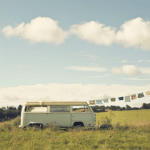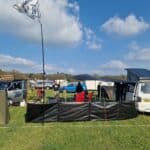Introduction
Your campervan is more than just a mode of transportation; it’s your home on wheels, your trusty companion on countless adventures. Regular maintenance is essential to ensure it continues to serve you faithfully. At Vandemonium Outfitters, we’re committed to helping you keep your campervan in top shape. In this comprehensive maintenance checklist, we’ll guide you through the steps to maintain your campervan’s functionality, safety, and longevity. So, put on your campervan hoodie, and let’s dive into the world of campervan care. It’s the Ultimate Campervan Maintenance Checklist.
- Chapter 1: Routine Inspections
- Chapter 2: Cleaning and Upkeep
- Chapter 3: Electrical Systems
- Chapter 4: Plumbing and Water Systems
- Chapter 5: Safety Checks
- Chapter 6: Documentation: Your Campervan's Paper Trail
- Conclusion: The Ultimate Campervan Maintenance Checklist
- Campervan Journey Inspiration
Chapter 1: Routine Inspections

The Ultimate Campervan Maintenance Checklist
Your campervan’s health begins with routine inspections. Regularly checking key components can catch issues early and prevent costly breakdowns. Here’s a more detailed look at each aspect of this essential chapter:
Tyres
Check tyre pressure and condition regularly:
Properly inflated tyres are crucial for safe driving. Ensure your tyres are inflated to the recommended pressure levels specified in your campervan’s manual. Check the tyre condition for any of the following:
Tread Wear:
Examine the tyre treads for even wear. Uneven wear patterns may indicate alignment or suspension issues that need addressing.
Tire Damage:
Inspect the tyres for punctures, cuts, or bulges in the sidewalls. Any damage should be addressed promptly to prevent blowouts on the road.
Tire Age:
Consider the age of your tyres. Even with sufficient tread, tyres older than six years may be prone to failure and should be replaced.
Brakes
Have your brakes inspected by a professional regularly:
Ensuring that your brakes are in good working order is crucial for your safety. Here’s what a brake inspection involves:
Brake Pads and Rotors:
A professional will check the condition of your brake pads and rotors. Worn-out brake pads can lead to reduced braking efficiency and, in severe cases, brake failure.
Brake Fluid:
Brake fluid should be checked and replaced if it appears discoloured or has moisture contamination. Contaminated brake fluid can decrease brake performance.
Brake Lines:
Inspect brake lines for signs of leaks, corrosion, or damage. Damaged brake lines can result in brake fluid loss and brake failure.
Fluids
Regularly check engine oil, transmission fluid, brake fluid, and coolant levels:
Proper fluid levels are essential for the smooth operation of your campervan’s engine and systems. Here’s what you need to know:
Engine Oil:
Check your engine oil regularly using the dipstick. Low oil levels or dirty oil can lead to engine damage. Top up or change the oil as recommended in your owner’s manual.
Transmission Fluid:
Ensure your campervan’s transmission fluid is at the correct level. Low or contaminated transmission fluid can result in transmission problems. Follow your vehicle’s maintenance schedule for fluid changes.
Brake Fluid:
Brake fluid should be inspected for proper levels and quality. Brake fluid absorbs moisture over time, reducing its effectiveness. Replace the brake fluid if necessary.
Coolant:
Maintain the correct coolant level in your campervan’s radiator to prevent engine overheating. Ensure that the coolant mixture is appropriate for the temperature range in which you’ll be travelling.
Lights
Test all exterior and interior lights:
Proper lighting is essential for your safety and the safety of others on the road. Here’s what you should check:
Headlights:
Ensure that your headlights provide proper illumination and are correctly aligned. Cloudy or damaged headlight lenses can reduce visibility and should be replaced.
Taillights and Brake Lights:
Test your taillights and brake lights to ensure they work correctly. These lights are crucial for signalling your intentions to other drivers.
Turn Signals:
Verify that your turn signals operate as intended. Malfunctioning turn signals can lead to accidents and confusion on the road.
Interior Lights:
Remember to check the interior lights of your campervan. They’re essential for a comfortable living space during nighttime hours.
Belts and Hoses
Inspect belts and hoses for signs of wear or damage:
Belts and hoses play a vital role in your campervan’s operation. Here’s what to look for:
Serpentine Belt:
Check the serpentine belt for cracks, fraying, or any signs of wear. A failing serpentine belt can damage the engine and cause breakdowns.
Timing Belt:
If your campervan has a timing belt, inspect it according to the manufacturer’s recommendations. Timing belt failure can result in severe engine damage.
Coolant Hoses:
Examine coolant hoses for leaks, bulges, or cracks. Damaged hoses can lead to coolant loss, engine overheating, and costly repairs.
Accessory Drive Belts:
If your campervan has accessory drive belts (e.g., alternator belt, power steering belt), check them for wear and proper tension. A broken accessory belt can disable critical systems.
By performing these detailed inspections regularly, you can ensure that your campervan remains safe, reliable, and ready for your next adventure.
Chapter 2: Cleaning and Upkeep

The Ultimate Campervan Maintenance Checklist
A well-maintained campervan enhances its visual appeal and contributes to its overall performance and longevity. This chapter will delve into the essential steps for keeping your campervan’s interior and exterior pristine, ensuring it remains a comfortable and reliable home on wheels.
Interior
The interior of your campervan is your sanctuary on the road, and a clean, clutter-free space can significantly enhance your travel experience. Here’s how to ensure your campervan’s interior stays inviting and cosy:
Regular Cleaning:
Make it a habit to clean your campervan’s interior regularly. Vacuum the carpets, wipe down surfaces, and dust off any surfaces to maintain a fresh and inviting environment. A tidy interior looks great and promotes a healthier living space.
Upholstery Care:
Campervan upholstery can accumulate dirt and odours over time. Use appropriate cleaning products for your upholstery type to remove stains and keep the seating area comfortable and inviting. Consider using seat covers to protect upholstery from wear and tear.
Cabinets and Storage:
Organize cabinets and storage areas to minimize clutter. Ensure that items are securely stored and won’t shift while you’re on the move. Well-organized storage makes it easier to find what you need and maintains a tidy interior.
Flooring Maintenance:
Routine maintenance is essential if your campervan has carpet, vinyl, or other flooring materials. Vacuum or sweep to remove dirt and debris, and clean with suitable products to maintain the appearance and integrity of your flooring.
Exterior
The exterior of your campervan is the first thing people notice, and its condition can affect aesthetics and functionality. Proper cleaning and maintenance can help prevent corrosion and extend your campervan’s lifespan. Here’s how to keep the exterior in top shape:
Regular Washing:
Washing your campervan’s exterior is not just about appearance; it’s crucial in preventing corrosion. Dirt, grime, and road salt can damage the paint and body over time. Use mild detergent and a soft brush or sponge to clean the surface. Pay attention to the wheels and wheel wells, where road debris accumulates.
Windows:
Clean the windows regularly to ensure optimal visibility. Use glass cleaner or a vinegar and water solution to remove smudges and streaks. Clean windows not only improve your view but also enhance safety on the road.
Roof and Seals:
Pay attention to the roof of your campervan. Regularly inspect roof seals and seams for wear, cracks, or leaks. Damaged seals can lead to water infiltration and costly repairs. Address any issues promptly to prevent water damage to the interior.
Awning Care:
If your campervan is equipped with an awning, inspect it for signs of wear or damage. Clean the awning fabric as the manufacturer recommends to extend its lifespan and ensure smooth operation.
Following these cleaning and upkeep guidelines, you can maintain a clean, comfortable, and visually appealing interior while protecting the exterior from damage and corrosion. A well-maintained campervan enhances your travel experience and ensures that your home on wheels remains in top condition for many future adventures.
Chapter 3: Electrical Systems

The Ultimate Campervan Maintenance Checklist
Your campervan’s electrical systems are the lifeline of modern travel, providing power to various appliances, lighting, and accessories. Ensuring these systems are in top shape is essential for a comfortable and hassle-free journey. This chapter will explore the key components of your campervan’s electrical systems and provide maintenance tips to keep them running smoothly.
Battery
The battery in your campervan serves as its electrical heart, supplying power to various onboard systems. To ensure it functions reliably throughout your journey, follow these steps:
Regular Inspection
Periodically inspect your campervan’s battery to check for signs of wear, damage, or corrosion on the terminals. Clean any corrosion with a battery terminal cleaner or a mixture of baking soda and water. Ensure that the battery is securely fastened in place.
Charge Level
Check the charge level of your campervan’s battery regularly, especially before embarking on a trip. Low battery voltage can result in starting problems and may prevent appliances from operating correctly. Use a multimeter to measure the battery’s voltage, and consider investing in a battery tester for more precise readings.
Charging Routine
If your campervan has a dual-battery system, ensure the auxiliary battery is charging correctly. Follow the manufacturer’s guidelines for maintaining the battery, including topping up water levels (if applicable) and using a suitable battery charger when necessary.
Electrical Connections
Your campervan’s electrical connections and wiring are critical in delivering power to various components. Ensuring these connections are secure and free from damage is essential for trouble-free operation:
Visual Inspection
Regularly inspect all electrical connections and wiring throughout your campervan. Look for signs of fraying, exposed wires, loose connections, or melted insulation. Any abnormalities should be addressed promptly.
Tightening and Securing
Check that all electrical connections are snugly fastened. Over time, vibrations from the road can cause nuts and bolts to loosen. Ensure that wires are properly secured and organized to prevent chafing or entanglement.
Waterproofing
Pay special attention to electrical connections and components in exposed or exterior areas. Ensure that these connections are adequately waterproofed to prevent moisture ingress, which can lead to electrical shorts and damage.
Solar Panels
If your campervan is equipped with solar panels, these eco-friendly power generators can enhance your self-sufficiency on the road. To maximize their efficiency and lifespan, consider the following maintenance practices:
Regular Cleaning
Solar panels are exposed to the elements and can accumulate dust, dirt, and debris over time. Clean the panels regularly with a soft brush or cloth and a mild detergent. Avoid abrasive materials that could scratch the surface. Clean panels generate more energy.
Inspection
Periodically inspect the condition of your solar panels. Look for any cracks, chips, or damage to the glass surface. Damaged panels should be repaired or replaced promptly to maintain optimal performance.
Tilt and Orientation
Depending on your campervan’s design, you may have the option to adjust the tilt and orientation of your solar panels to capture more sunlight. Adjust them according to the angle of the sun to maximize energy production.
Addressing these critical aspects of your campervan’s electrical systems can ensure a reliable and efficient power supply throughout your journeys. A well-maintained electrical system enhances your camping experience and provides peace of mind on the road.
Chapter 4: Plumbing and Water Systems

The Ultimate Campervan Maintenance Checklist
Your campervan’s plumbing and water systems are vital for a comfortable and hygienic living experience on the road. This chapter delves into the essential aspects of maintaining these systems to ensure they function flawlessly during your adventures.
Water Tanks: The Lifeline of Hydration
Your campervan’s water tanks are the unsung heroes, providing you with a reliable source of clean water and facilitating wastewater disposal. To maintain a continuous and safe water supply, follow these guidelines:
Regular Cleaning and Sanitization
Periodically clean and sanitize both your freshwater and wastewater tanks. This essential step helps prevent unpleasant odours and contamination of your drinking water. Here’s how:
1. Drain Tanks
Start by draining both tanks completely. You can do this at an appropriate disposal point, such as a designated RV dump station.
2. Cleaning Solution
Prepare a cleaning solution using a mild, RV-specific tank cleaner or a mixture of baking soda and water. Consult your campervan’s manual for recommended cleaning agents.
3. Fill with Solution
Fill your freshwater tank with the cleaning solution, ensuring it reaches all corners of the tank.
4. Agitate and Flush
Drive your campervan briefly, allowing the solution to agitate and thoroughly clean the tank. Next, drain the tank entirely.
5. Rinse and Repeat
Refill the fresh water tank with clean water and flush it several times to remove any residual cleaning solution. Repeat this rinsing process until the water runs clear, indicating that the tank is free of cleaning agents.
Wastewater Tank
Follow a similar process for your wastewater tank. Use an appropriate tank cleaner designed to break down waste and prevent odours.
Regularly cleaning and sanitizing your water tanks ensures a safe and hygienic water supply, allowing you to stay refreshed throughout your journey.
Pipes and Hoses: Guard Against Leaks
The intricate network of pipes and hoses in your campervan is crucial in transporting water to and from various fixtures. To prevent water-related mishaps, adopt these practices:
Frequent Visual Inspection
Regularly inspect all pipes and hoses for signs of wear, damage, or leaks. A visual check can help identify issues before they escalate. Pay particular attention to connections and junctions where leaks are more likely to occur.
Replacement of Faulty Components
Promptly replace the affected pipes or hoses upon discovering any damage or leaks. Ensure you use high-quality replacement parts compatible with your campervan’s plumbing system. Properly seal all connections to prevent leaks.
Weather Protection
Protect your campervan’s plumbing components from extreme weather conditions. During cold weather, ensure that exposed pipes and hoses are insulated or enclosed in heated compartments to prevent freezing.
Toilet and Sewage: Hygiene Matters
Proper maintenance is essential for campervans equipped with toilet systems to uphold hygiene and prevent unpleasant odours. Follow these guidelines:
Manufacturer’s Guidelines
Refer to your campervan’s manual for specific maintenance instructions provided by the toilet system manufacturer. Adhere to these guidelines to ensure the longevity and functionality of your toilet.
Regular Cleaning
Clean the toilet bowl and surrounding area regularly using RV-friendly toilet cleaners. These cleaners are designed to break down waste and prevent clogs. Avoid using harsh chemicals that can damage the toilet’s components.
Odor Control
To control odours, consider using specialized RV toilet chemicals or drop-in tablets. These products help break down waste and neutralize odours effectively.
Following these practices ensures that your campervan’s plumbing and water systems remain in excellent condition. This will allow you to enjoy a clean and reliable water supply throughout your travels, and a well-maintained plumbing system contributes to a more comfortable and enjoyable camping experience.
Chapter 5: Safety Checks

The Ultimate Campervan Maintenance Checklist
Safety should always be a top priority when travelling in your campervan. Here’s how to ensure a safe journey for you and your fellow travellers.
Fire Extinguisher: Your First Line of Defense
Your campervan should be equipped with a functioning fire extinguisher, and everyone on board should know its location and how to use it. Fire safety is paramount, and having a fire extinguisher can make a critical difference in an emergency.
Inspection and Maintenance
Regular Checks
Periodically inspect the fire extinguisher to ensure it is in good condition. Check for visible damage, corrosion, or any signs of tampering.
Pressure Gauge
Verify the pressure gauge reading, which should be within the recommended range. If it falls outside this range, replace or recharge the extinguisher.
Seals and Safety Pin
Ensure the safety seals and pull-pin are intact. If the seal is broken or missing, it might indicate prior use or tampering.
Expiry Date
Check the extinguisher’s expiration date. Fire extinguishers typically have a shelf life of 10-15 years, after which they should be replaced.
Training
Familiarize yourself and your fellow travellers with the proper operation of the fire extinguisher. Knowing how to use it effectively is crucial in an emergency.
Smoke and Carbon Monoxide Alarms: Early Warning Systems
Test smoke and carbon monoxide (CO) alarms regularly to keep your living space safe. These alarms can save lives by alerting you to potential dangers.
Regular Testing
Weekly Tests
Conduct weekly tests of your smoke and CO alarms. Most alarms have a test button that you can press to ensure they are working correctly.
Battery Replacement
Replace the batteries in your alarms at least once a year or as the manufacturer recommends. Some alarms come with sealed, long-life batteries that don’t require replacement.
Cleaning and Maintenance
Periodically clean the alarms to remove dust and debris, which can affect their sensitivity. Follow the manufacturer’s instructions for maintenance.
First Aid Kit: Your Lifesaver on the Road
A well-stocked first aid kit is a must-have for any campervan journey. It can be a lifesaver when you encounter minor injuries or medical emergencies on the road.
Essential Supplies
Adhesive Bandages
Various sizes of adhesive bandages are used to cover cuts, scrapes, and blisters.
Sterile Gauze Pads and Dressings
Used for larger wounds and to stop bleeding.
Antiseptic Wipes
Alcohol or antiseptic wipes are used to clean wounds and prevent infection.
Tweezers and Scissors
Tweezers are used to remove splinters or debris, and scissors are used to cut tape, gauze, or clothing.
Pain Relievers
Over-the-counter pain relievers such as ibuprofen or acetaminophen.
Thermometer
A digital thermometer to monitor body temperature.
Cotton Balls and Swabs
Helpful in applying antiseptics or creams.
First Aid Manual
A comprehensive first aid manual or instructions for providing primary medical care.
Emergency Contact Information
Include a list of emergency contacts, such as local hospitals, clinics, and poison control centres, and contact information for your fellow travellers.
Ensure your first aid kit is well-maintained and replenished as items are used or expire.
Emergency Contacts: Be Prepared for the Unexpected
Carry a list of emergency contacts and know the location of the nearest medical facilities and service stations along your route. Being prepared for emergencies is essential for your safety.
Emergency Contact List
Local Emergency Services
Include the emergency phone number for police, fire, and medical assistance in the area you are travelling.
Campervan Rental Company
Keep the contact information for your campervan rental company in case you need assistance with vehicle-related issues.
Family and Friends
Share your itinerary and contact information with trusted friends or family members who can assist in emergencies.
Roadside Assistance
If you have a roadside assistance service, have their contact information readily available.
Local Hospitals and Clinics
Research and note medical facilities’ locations and contact details along your route.
Poison Control
Include the number of poison control centres in case of accidental ingestion or exposure to hazardous substances.
With this information, you can quickly respond to emergencies and seek assistance when needed, ensuring a safer and more secure campervan journey for all.
Chapter 6: Documentation: Your Campervan’s Paper Trail

Efficient organization of your campervan’s documentation is vital for reference and warranty purposes. Here’s a closer look at what you should keep track of:
Manuals: Your Knowledge Base
Keep all campervan manuals and documentation neatly organized and readily accessible. Manuals are your go-to resource for understanding your campervan’s operation and maintenance requirements.
Manufacturer’s Manual
This comprehensive guide provides essential information about your campervan’s specifications, features, and maintenance recommendations. It’s your knowledge base for understanding how everything works.
Component Manuals
Your campervan is a complex machine with various components such as the refrigerator, air conditioning, heating, etc. Maintain individual manuals for these components to understand their operation, troubleshooting, and maintenance procedures.
Appliance Manuals
If your campervan includes appliances like a stove, microwave, or water heater, keep their manuals handy. These guides offer insights into proper usage, cleaning, and maintenance.
Warranty Information
Store warranty documentation separately, making it easy to access if you need to make a claim. Understand the terms and duration of your campervan’s warranty coverage.
Maintenance Records: The Service Diary
Maintaining a comprehensive log of all maintenance and repairs performed on your campervan is more than just record-keeping—it’s a proactive approach to ensuring your campervan’s longevity and reliability. Here’s how to keep it organized:
Service Dates
Record the dates of all maintenance tasks, including oil changes, inspections, component replacements, and more. This timeline helps you stay on top of routine maintenance schedules.
Detailed Descriptions
Provide detailed descriptions of the work performed for each maintenance or repair task. Include information on parts replaced, problems addressed, and solutions applied. The more specific, the better.
Service Provider Details
Note the details of the service provider or mechanic who performed the work. Include contact information, the service centre name, and any relevant notes about the service quality.
Odometer Readings
Record the campervan’s odometer readings at the time of each service. Tracking mileage can help identify maintenance patterns and potential issues.
Invoices and Receipts
Keep copies of all invoices and receipts related to maintenance and repairs. These documents are proof of service and may be required for warranty claims.
Visual Documentation
Consider taking photographs before and after major maintenance or repair tasks. Visual documentation can provide a clearer picture of the work performed and the condition of components.
Future Maintenance Reminders
Use your maintenance records to anticipate future service needs. This proactive approach can help you plan and budget for upcoming maintenance tasks.
A Well-Documented Journey
Efficiently managing your campervan’s documentation ensures you’re well-prepared for any situation. Whether consulting a manual for troubleshooting or providing a comprehensive service history for warranty claims, organized documentation simplifies your campervan journey.
So, invest the time in setting up your campervan’s paper trail. It’s a small effort that pays off with enhanced peace of mind and the knowledge that you’re taking excellent care of your cherished home on wheels.
Conclusion: The Ultimate Campervan Maintenance Checklist
Regular campervan maintenance is the key to a safe, reliable, and enjoyable journey. By following this comprehensive checklist, you’ll be well-prepared to keep your home on wheels in top shape. So, don’t wait—grab your campervan hoodie and start ticking off those maintenance tasks. Your next adventure awaits!
Campervan Journey Inspiration
Ready to kickstart your campervan adventure? Don’t stop here! Vandemonium Outfitters offers a treasure trove of destination-specific blogs, each packed with detailed itineraries and insider tips to make your journey extraordinary. Whether you’re seeking rugged coastlines, tranquil lakes, historic villages, or vibrant cities, we’ve got you covered. Explore the unique charm of each destination by clicking on the links below:
The Causeway Coastal Route, Northern Ireland
The Wild Atlantic Way, Ireland
Snowdonia National Park, Wales
The Pembrokeshire Coast, Wales
For even more campervan inspiration and practical tips, delve into our main blog, The Ultimate Guide to Campervan Road Trips: 10 Spectacular UK Destinations. Vandemonium Outfitters is your go-to source for creating memories that will last a lifetime. Stay tuned for more incredible journeys to explore and embrace the freedom of the open road!




